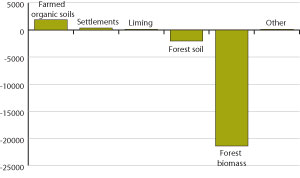| other hand, reduced grazing land in outlying
areas has led to an increase in vegetation and eventually larger
forest areas. Agricultural areas change their form of production
or are abandoned. Carbon is stored in soil and in the trunks,
branches, and roots of trees. Land-use change thus leads to a
change in carbon storage, and indirectly to emissions and
removal of CO2. Carbon removal in Norway from
land-use change is, however, relatively small compared to the
removal by existing forests. It is also difficult to measure.
Changes in forest management practices, especially decreased
logging, has led to an increase in the wood volume and carbon
stored in soils in existing forest areas. This is what
contributes to the bulk of the carbon sequestration. Climate
change (warmer temperatures) and the supply of nitrogen also
contribute to increasing woody biomass and forest areas, but it
is not possible to say how much of the carbon removal is caused
by these factors compared to changes in forest management
practices. Figure 1 shows the greenhouse gas budget for forests
and other land use in Norway for 2003. The largest source of
emissions is farmed organic soils, which releases 2 million tons
of CO2 per year.
The removal, which equals about 21 tons of CO2 per
year, cannot fully be credited in the Kyoto Protocol. The
Protocol requires Parties to include removals and emissions of
greenhouse gases from afforestation and reforestation of new
areas and deforestation of existing forest areas throughout the
commitment period 2008-2012. These are activities that are not
expected to constitute a particularly large net carbon removal
for Norway. But the Protocol also allows countries to claim
credits for CO2 removals from forest management
implemented in existing forest areas. The Protocol allows Norway
to claim credits for up to 1.5 million tons per year in the
period 2008-2012, equivalent to three percent of the emissions
level in 1990, from such areas. The Parties can also claim
credits for measures to increase removals or reduce emissions
from agricultural soil and other vegetation. The Bondevik
administration has specified that it does not wish to take
advantage of the opportunity to claim credits for removals from
normal forest management (see St. meld. no. 15, 2001-2002). It
has not taken a position on whether it wishes to include
agricultural soil or other vegetation. In the course of next
year, the government must make a final decision on whether it
wishes to claim credits for these types of forest management
measures (as well as measures implemented in agriculture or
other land uses) and communicate this decision to the UN
Framework Convention on Climate Change (UNFCCC) by the end of
2006.
There has been discussion about to what degree carbon removal
in forests is verifiable enough to be counted as a valid climate
measure. For Norway, the estimates are largely based on data
from the forest inventory carried out by NIJOS. The increase in
removals from existing forest areas is thus measured with great
certainty, and use of data from NIJOS ensures that carbon
storage in forests can be traced over time, thus monitoring
whether the removal that Norway gets credit for is permanent.
However, there is greater uncertainty connected to changes in
carbon in agricultural and forest soil because fewer
measurements of carbon in soil have been taken and the models
are poorly developed. Nor can the land inventory always capture
land-use changes on smaller scales, such as road construction or
construction of smaller residential areas. Moreover, the land
inventory does not currently cover areas in the proximity of the
tree line or Finnmark. This means that increased removals in
these areas are not reflected in the calculations. The joint
report from NIJOS, Statistics Norway and CICERO concludes that
the bulk of emissions and removal data from Norway have a high
degree of certainty, but that there is a need for further
development of data collection to fully satisfy the reporting
requirements and to reduce remaining uncertainty.
Reference
CICERO, NIJOS and Statistics Norway. (Stein Tomter, Terje
Gobakken, Harald Aalde, Ketil Flugsrud, Vilni Verner Holst
Bloch, Britta Hoem og Kristin Rypdal).
Emissions and removals of GHG from land use land-use change and
forestry in Norway. NIJOS-rapport 11. ISBN 82-7464-352-6.
Originally published at:
http://www.cicero.uio.no/
|
